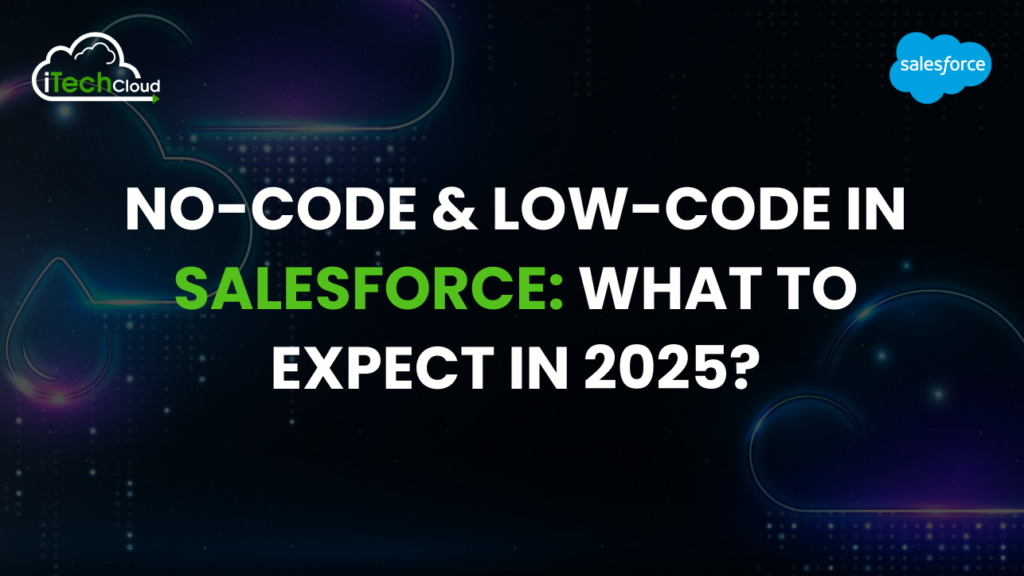No-Code & Low-Code in Salesforce: What to Expect in 2025?

The no-code/low-code Salesforce movement is playing a major role in this transformation. As organizations strive for faster digital innovation with minimal reliance on traditional coding, no-code and low-code tools have emerged as game changers. In 2025, Salesforce is expected to further push the boundaries of these development paradigms, enabling businesses to accelerate their digital transformation efforts with ease.
Table of Contents
Understanding No-Code & Low-Code in Salesforce
What is no-code development?
No-code development enables users to build applications, automate processes, and customize functionalities without writing a single line of code. It relies on visual interfaces, drag-and-drop components, and declarative tools. Salesforce’s no-code capabilities are powered by tools like Flow Builder, Lightning App Builder, and Dynamic Forms.
What is low-code development?
Low-code development involves minimal coding to create applications, automate business processes, and integrate systems. It provides pre-built components, reusable code snippets, and scripting capabilities. Salesforce’s low-code solutions include Apex, Lightning Web Components (LWC), and OmniStudio.
The Growing Adoption of No-Code & Low-Code in Salesforce
No-code and low-code tools reduce the time, cost, and complexity associated with traditional development. Salesforce continued investment in these tools is driving widespread adoption across industries.
Key Trends in No-Code & Low-Code for Salesforce in 2025
1. AI-Powered No-Code & Low-Code Development
Salesforce has been integrating AI into its platform, and in 2025, AI-driven no-code and low-code development will become more prevalent.
- Einstein AI & Generative AI: Salesforce Einstein will assist in auto-generating flows, suggesting automation, and optimizing workflows.
- AI-Based Code Generation: AI will help developers write Apex code efficiently, reducing manual effort.
- Natural Language Processing (NLP): Users will be able to create workflows using conversational commands, making no-code development even more accessible.
2. Expansion of Salesforce Flow and Process Automation
Salesforce Flow has already transformed process automation, and in 2025, it will become even more powerful.
- Pre-Built Flow Templates: More industry-specific templates will be available, reducing setup time.
- Integration Capabilities: Improved connectors will allow seamless integrations with third-party applications.
- Low-Code Orchestration: Businesses will be able to create end-to-end process automations with minimal coding.
3. Hyper-Personalization with No-Code & Low-Code Tools
Customization is a key focus for Salesforce, and in 2025, users will experience greater personalization without coding.
- Dynamic Pages & Layouts: Dynamic Forms & Dynamic Actions will provide personalized UI experiences.
- Low-Code AI-Powered Personalization: Einstein AI will suggest content and actions based on user behavior.
- Customizable Lightning Components: Drag-and-drop components will allow for more flexible UI modifications.
4. Security and Governance for No-Code & Low-Code Solutions
As more companies adopt no-code and low-code development, security concerns will grow.
- Built-in Compliance & Security Features: Salesforce will enhance compliance tools to ensure governance.
- Role-Based Access Control (RBAC): Admins will have more control over user permissions and data access.
- Automated Security Audits: AI-driven security scans will detect potential vulnerabilities in no-code/low-code solutions.
5. Citizen Development and the Rise of Business Users as Builders
The demand for IT resources has outpaced supply, leading to the rise of citizen developers non-technical business users who build apps without coding.
- Improved Learning Resources: Salesforce will offer more Trailhead modules and guided learning experiences.
- Empowered Business Users: More intuitive tools will allow employees to create solutions independently.
- Collaborative Development: IT teams and business users will work together through fusion teams.
6. Evolution of Salesforce AppExchange with No-Code & Low-Code Tools
Salesforce AppExchange will continue to expand its offerings.
- Pre-Built Low-Code/No-Code Apps: More out-of-the-box apps will be available for rapid deployment.
- Marketplace for No-Code Components: Users will be able to find and deploy pre-configured components.
- App Customization: Businesses can tailor AppExchange apps without coding.
7. Low-Code DevOps and Continuous Delivery
DevOps is no longer just for traditional development; low-code DevOps will become mainstream.
- Automated Deployment Pipelines: Low-code tools will facilitate smoother CI/CD processes.
- AI-Powered Debugging: AI will assist in identifying and fixing issues before deployment.
- Version Control for No-Code & Low-Code Apps: Enhanced governance tools will ensure safer rollouts.
How Businesses Can Leverage No-Code & Low-Code in Salesforce
1. Accelerate Digital Transformation
Salesforce no-code and low-code tools, businesses can automate processes, enhance customer experiences, and launch new services faster.
2. Reduce IT Dependency
With easy-to-use declarative tools, non-technical users can build applications and workflows, reducing the burden on IT teams.
3. Improve Business Agility
Businesses can quickly adapt to market changes by rapidly deploying and modifying applications without lengthy development cycles.
4. Optimize Costs
Minimizing traditional coding requirements lowers development costs and reduces the need for expensive technical resources.
5. Collaboration Between IT and Business Teams
Fusion teams, consisting of both IT and business users, can work together to create tailored solutions that align with organizational goals.
Challenges and Considerations
No-code and low-code development come with challenges.
1. Complexity Limitations:
No-code solutions are ideal for simple tasks, but complex applications may still require coding.
2. Governance & Compliance:
Organizations must implement strong governance policies to manage security risks.
3. Integration Challenges:
Seamlessly integrating no-code/low-code applications with legacy systems can be difficult.
4. Skill Development:
Business users need proper training to leverage these tools effectively.
Conclusion
Salesforce no-code and low-code capabilities will continue to evolve in 2025, enabling businesses to innovate faster, reduce costs, and enhance agility. With AI-powered automation, hyper-personalization, enhanced security, and greater citizen developer participation, the Salesforce ecosystem is set to redefine the future of application development.

